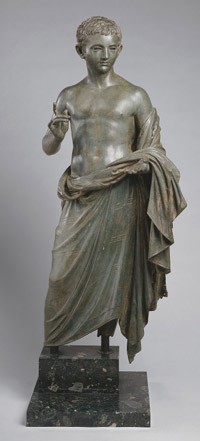By the first century AD, Rome dominated most of the Hellenistic world and was a leading center for the production of art in Greek styles, both past and present. The Roman defeat of the last Hellenistic dynasty at the Battle of Actium in 31 BC traditionally marks the rise of the Roman Empire and the end of the Hellenistic era. Admiration for the art and culture of Greece, however, remained strong in imperial Rome, where artists created sculptures in the Hellenistic tradition well into the second century AD. Augustus, the first Roman emperor (ruled 27 BC – AD 14), favored the Classical style for much of his official art to associate his reign with the “golden age” of fifth-century Athens under Pericles. The return to the idealized portraiture of Classical Greece is exemplified by the sculpture of a boy wearing a himation (a large, rectangular cloth wrapped around the body), shown at the left. Found on Rhodes, an island noted for its bronzeworkers, this graceful statue recalls images of Augustus and his family, but more likely portrays a member of the local aristocracy of Rhodes, his image emulating imperial portraits.
Pictured: Portrait of a Boy, 25 BC – AD 25; bronze. Lent by The Metropolitan Museum of Art
